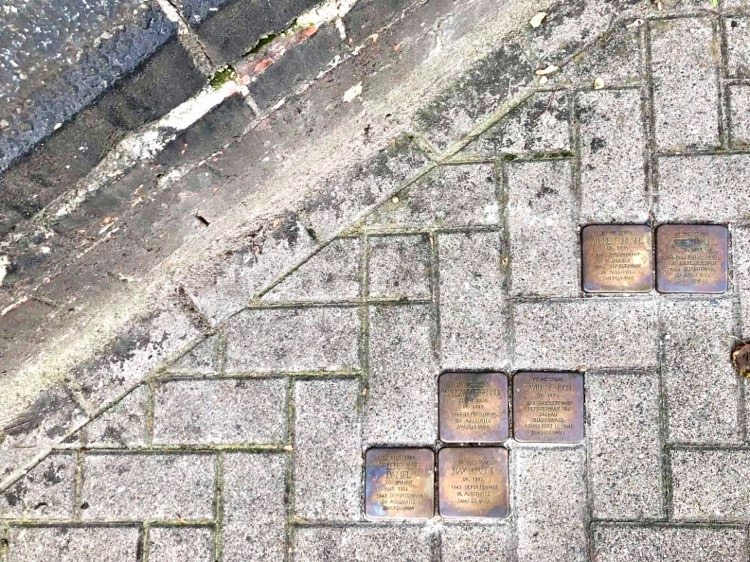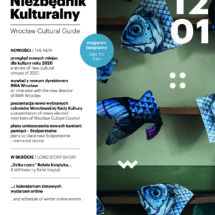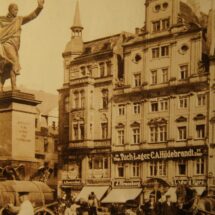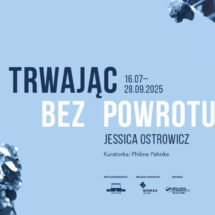
19.01
In November 2020, we organized two special events: the debate on “Stolpersteine - who commemorates whom and for whom?” with the participation of Ramona Bräu, Mikołaj Grynberg, Anna Makówka-Kwapisiewicz and Agata Ganiebna, and a webinar for artists around the Arolsen Archives, i.e. the center for documenting the fate of the victims of the National Socialist regime and survivors.
Both focused on the issue of Stolpersteine and their planned placement at our headquarters, the former Oppenheim House in Wrocław. In 2020, Karolina Jara’s text devoted to these issues appeared in the Wrocław Cultural Essentials. We encourage you to read!
___________________
“Stolpersteine” or memory you can stumble on
In German, the “Stolpersteine” means a “stumbling stone.” These are small memorials for the victims of Nazism, built into the sidewalk in front of the house that was their last home. The 10 by 10-centimetre concrete cubes are covered with a brass tile, engraved with the first name, last name, date of birth, as well as the date and place of death.
The idea is very simple and evokes great emotions, experienced by everybody who accidentally stumbles upon one of these stones, stops and thinks for a brief moment about the fate of a particular person, sometimes even a whole family. This is what makes the project so powerful – every stone is a human being, and we stand in front of their home, which they had to leave, usually being sent to death.
A controversial project
Although the initiative is not yet widespread in Poland, there are already over 75,000 stones in dozens of European countries. The concept of commemorating the victims of the Nazi regime – not only Jews but also homosexuals, Roma and Sinti, as well as other repressed groups, was created by the German artist Gunter Demnig in the 1990s. The project, which serves the role of a “dispersed monument” is important because it enables commemorating ordinary people who are unlikely to have a normal monument and sensitises the passers-by to tragic events that took place only a few decades ago. Everything shows that with the current rise of intolerance and nationalistic tendencies, the importance of the Stolpersteine is also growing.
This unusual way of commemoration arose controversies in Germany right from the get go – and not only among the representatives of the far-right wing organisations, who vehemently opposed installing the stones, but also the owners of houses where the stones were supposed to be installed, fearing that their homes would lose value. In several cities, including Munich, even the local Jewish communities have expressed their opposition, arguing that the Stolpersteine insulted the memory of the Holocaust victims, since they are installed in the pavement, which means that they will be walked on, and possibly soiled by humans and animals.
Complex procedures
Wrocław was the first Polish city where the Stolpersteine appeared, and to this day we have exactly 13 of them – the largest number among Polish cities. The first one – installed in 2008 on Nowowiejska Street – was dedicated to Edyta Stein. In 2016, new stones appeared on the initiative of members of the Zorek family (Jedności Narodowej 95) and Treitel (Świdnicka 39), and in 2019 six stones were installed at the intersection of Zielińskiego and Swobodna Streets.
The favourable attitude of the city magistrate and the support offered by Maciej Skroban from the Wrocław Municipal Office helped the family members wade through the bureaucracy, since the procedures are difficult to navigate – there is no separate procedure for this kind of installations in the pavement. Unfortunately, the next initiators have to be prepared for going through at least several months of processes, if they want to obtain the necessary permits.
The location of memory stones is a more or less complicated process, depending on the approach of a given magistrate. In Warsaw and Krakow, the Stolpersteine are nowhere to be seen, while in other cities, such as for example in Biala Podlaska, the entire process can be carried out without any complications whatsoever. Krakow saw a particularly tense situation – after obtaining all the relevant permits, the process was stopped dead in its tracks by the magistrate due to the opinion issued by the Institute of National Remembrance. Demnig’s project was considered to be incompatible with the culture of remembrance adopted in Poland and offending the dignity of the victims.
Time for the Oppenheim townhouse residents
An online debate was held in November, organised by OP ENHEIM, entitled Stolpersteine in Poland – commemoration – whom, by whom, for whom?. The participants jointly reflected on the reception of this project in Polish society. The very name of these stones in Polish is hardly obvious, as there are several ways to refer to these – as “memory stones” and “stumbling stones”. While the former draws attention to the key role of preserving or restoring the memory of the victims, the latter better reflects the original name of the project and the associated performative aspect, which is to take an accidental passer-by out of their comfort zone.
The debate was inspired by the plan to place the Stolpersteine with the names of Jewish residents of the Oppenheim townhouse in Wrocław’s Salt Square, currently the seat of OP ENHEIM, marking the closer cooperation with the German-Polish Foundation for the Preservation of Cultural Monuments [Deutsch-Polnische Stiftung Kulturpflege und Denkmalschutz].
The work on researching the history of the townhouse and its pre-war residents has been going on for a long time, which resulted, among others, in Lisa Höhenleitner’s book Dom Oppenheimów we Wrocławiu. Kamienica opowiada historię miasta published in 2018. The most information was gathered about the Herz family, who ran a famous shoe shop in the townhouse – they will be the theme of an upcoming project, carried out thanks to the grant awarded by the Jewish Historical Institute Association.
The knowledge about the Elsner family and the other residents of the townhouse is also constantly growing, thanks to contacts with Arolsen Archives – International Centre on Nazi Persecution and the largest archive of documents concerning victims and survivors. An important element of the planned installation of the Stolpersteine is a debate in the public sphere and education, as exemplified by the aforementioned debate and a webinar devoted to Arolsen Archives, addressed to people who deal with the issue of identity and memory in their artistic projects.
Karolina Jara
_______________
The text comes from the winter (12.2020 / 01.2021) issue of the “Wrocław Cultural Guide”.
Link: https://strefakultury.pl/wroclawski-niezbednik-kulturalny/








